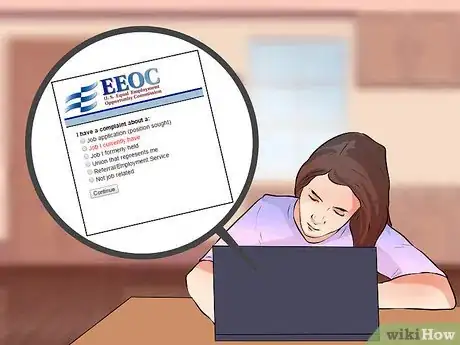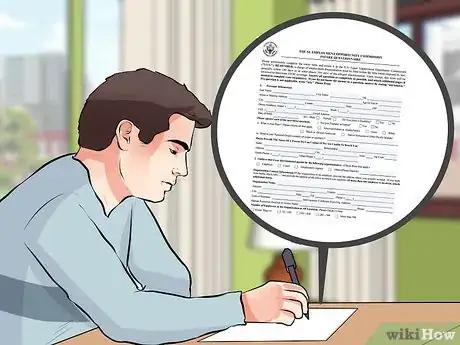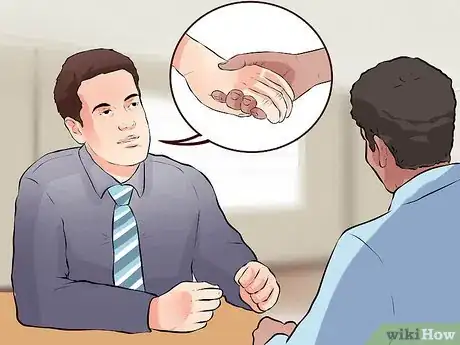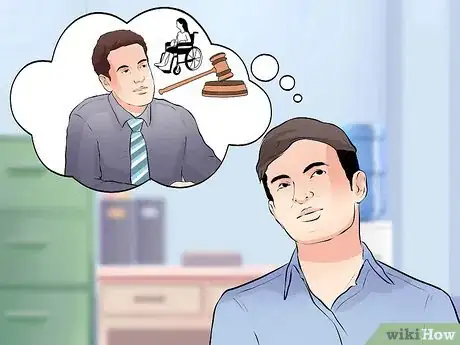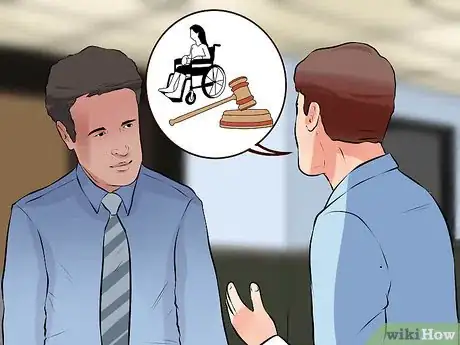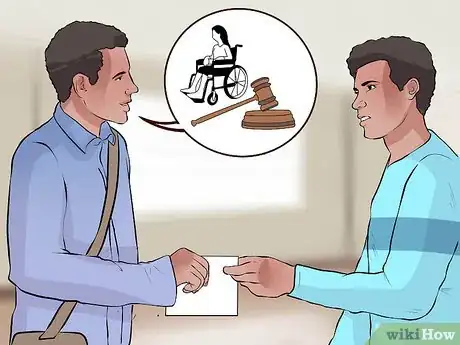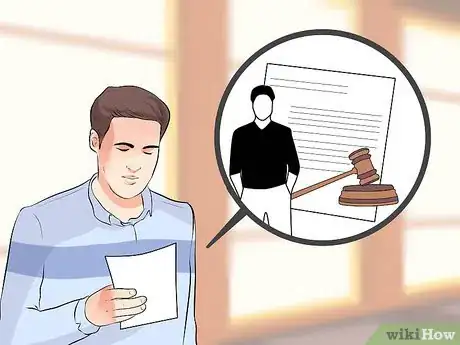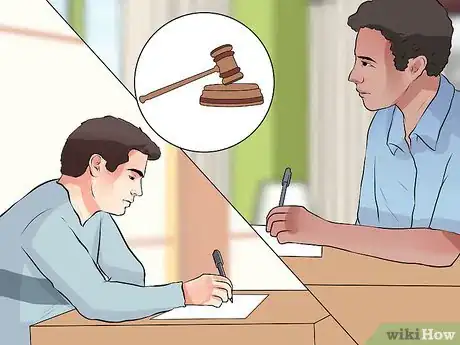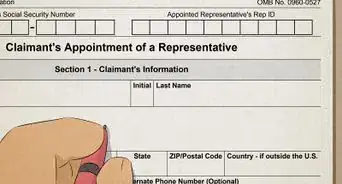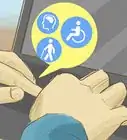This article was written by Jennifer Mueller, JD. Jennifer Mueller is an in-house legal expert at wikiHow. Jennifer reviews, fact-checks, and evaluates wikiHow's legal content to ensure thoroughness and accuracy. She received her JD from Indiana University Maurer School of Law in 2006.
There are 18 references cited in this article, which can be found at the bottom of the page.
This article has been viewed 15,676 times.
The Americans with Disabilities Act (ADA) and other federal and state laws prohibit employers from discriminating against people with disabilities and require them to make reasonable accommodations to enable disabled employees to perform their jobs. If your employer has discriminated against you because of a disability or refused to provide reasonable accommodations, you have the right to sue for disability discrimination. However, you must first exhaust all administrative remedies, which typically entails filing a charge with the Equal Employment Opportunity Commission (EEOC).[1] [2]
Steps
Exhausting Administrative Remedies
-
1Gather information about the discrimination you're facing. You can't begin the process of suing for disability discrimination without evidence of the discriminatory statements or conduct.[3] [4]
- For example, if you are a cashier at a grocery store, but have a disability that means you are unable to stand for more than an hour at a time, your supervisor should provide you with a stool or chair so you can perform your duties while sitting.
- If your supervisor refuses to provide you with a stool or chair, or penalizes you for leaning on a counter, this constitutes disability discrimination.
- It also is illegal for your supervisor or co-workers to harass or make fun of you because of your disability. This is considered disability discrimination even if you don't actually have the disability, they just perceive that you do.
- It's important to write down discriminatory conduct as soon as possible after it happens, so the details are still fresh in your mind. If you're facing continual harassment or discrimination, consider creating a journal or diary and recording each instance.
- Take down the date, time, location, and context (for example, if you are working your shift, on break, or clocking out). Write down the names not only of those responsible for the discrimination but also of any other co-workers who were present and may have witnessed the discriminatory conduct.
-
2File an internal complaint. Before you take your complaint to the next level, you should provide your employer with written notice of the problem and give him or her a chance to correct it.[5]
- Put your complaint in writing and let your employer know that you take the matter seriously and consider it illegal disability discrimination. Let your employer know what you want to happen as a result of your complaint – whether you want employees disciplined, just want the harassment to cease, or need a reasonable accommodation for your disability.
- Include specific details about the action or statements that you consider discriminatory, such as dates, times, locations, and the names of employees involved. Use your journal as a reference, if you made one. You might even consider making copies of those entries and including them verbatim.
- Keep in mind that if you don't feel comfortable bringing up the issue with your employer, you may be asked by an EEOC agent why you didn't notify your employer about the discrimination when you file your charge with the agency.
- Because federal law requires you to file a charge within 180 days of the most recent discriminatory act if you want to preserve your right to sue, keep track of the time that has passed and be ready to file a charge if your employer is unresponsive to your complaint.[6]
Advertisement -
3Determine your eligibility to file a state or federal charge. To preserve your right to sue for disability discrimination, you must first file a charge with state or federal administrative agencies.[7] [8] [9]
- The EEOC has an online assessment tool. By answering a few questions you can easily determine whether you're eligible to file a federal charge.
- If you aren't eligible to file a federal charge, you should check with your state's employment discrimination agency, particularly if you work for a small business. The ADA only applies to businesses with at least 15 employees who have worked at least 20 calendar weeks in a year, but state laws often apply to employers with fewer employees and may provide more comprehensive protection.
-
4Complete the EEOC intake questionnaire. The EEOC provides a standard three-page form for you to provide information about yourself, your employer, and the discrimination you're experiencing.[10]
- You can pick up a print questionnaire at any of the EEOC's field offices. However, it's a good idea to look at the form before you make the trip to the field office so you can make sure you have all the information you'll need to fill it out.
- If you're eligible to file a charge with both state and federal agencies, you may want to file your charge with both. Contact your state agency and find out if they have a dual-filing program. Many states will file a charge with the EEOC for you when you file a charge with the state agency.
-
5Submit your questionnaire. Once you've completed your questionnaire, you must submit it to your nearest EEOC field office so your charge can be evaluated.[11]
- The EEOC does not have a method by which you can submit a questionnaire online. You must send in a paper form.
- To locate the nearest EEOC field office, visit the EEOC's location map at http://www.eeoc.gov/field/index.cfm.
- The agency has 53 field offices, so if the one closest to you is too far away, call the office and explain this. An agent will assist you with mailing your questionnaire and ensuring that your charge is received before the deadline.
-
6Talk to an EEOC agent. Once your charge has been evaluated it will be assigned to an agent who will interview you regarding the discrimination you're experiencing.[12] [13]
- If you take your questionnaire into the field office in person, an EEOC agent typically will come out and talk to you about your charge on the same day.
- If you had to mail in your questionnaire, you either will be called by a field agent, or you will receive a list of questions in the mail that you must answer in writing and send back.
-
7Cooperate during the EEOC investigation. Within 10 days of your interview, the EEOC will send a copy of your charge to your employer along with instructions on how to proceed.[14] [15] [16]
- The EEOC either sends you and your employer to mediation, or assigns the case to an investigator and requires your employer to submit a written response to your charge.
- Typically, the EEOC process must be completed before you can file a lawsuit in court. If you reach a settlement with your employer during mediation, you may not even need to sue.
- If the EEOC ultimately finds no violation, you will receive a right-to-sue notice. If the EEOC does find a violation, but you are unable to reach a settlement with your employer through mediation and the EEOC's legal team declines to file a lawsuit on your behalf, you also will receive a right-to-sue notice.
- You can expect the administrative process to take about 180 days at most. If that period of time goes by and the investigation is not yet complete, you can request a right-to-sue notice from the EEOC. You also can request a right-to-sue notice before 180 days has passed, if it seems clear the EEOC won't complete its investigation by that deadline.
Filing Your Lawsuit
-
1Hire a disability discrimination attorney. If your case gets to the point where you're issued a right-to-sue letter, an experienced disability discrimination attorney is your best option to ensure your rights are protected.[17] [18] [19]
- Most disability discrimination attorneys will take your case on a contingency fee basis, meaning they receive no money unless you win or settle your case. That way you don't have to worry about out-of-pocket expenses for an attorney.
- If you know of a nonprofit group in your area that advocates for disability rights, you might start your attorney search there.
- You also can visit your state or local bar association's website and search for disability attorneys. Many bar associations have referral services that will provide you with names of attorneys that take cases like yours after you answer a few questions or briefly describe your issue.
- Make an effort to interview at least three attorneys if possible before you pick one. Keep in mind that all employment discrimination cases are different, so try to pick someone who has specific experience handling disability discrimination cases, or who specializes in disability law.
-
2Discuss your case with your attorney. Your attorney will need all the details you have about the discrimination you're experiencing and the people involved so he or she can draft your complaint.[20]
- You can start by giving your attorney copies of all the information you provided to the EEOC, as well as any information you provided to your employer or any journal you were keeping of the discriminatory incidents.
- Your attorney likely will have questions for you as well, regarding the discrimination and your relationship with your employer in general. Answer these questions as completely and openly as possible.
- Once your attorney has the necessary information, he or she will draft a complaint for you to initiate your lawsuit. Your complaint will include information about you and your employer along with your allegations against your employer and how they violate the law.[21] [22]
- Your complaint also will detail the injuries or losses you've suffered as a result of the discrimination, and the amount of monetary damages or other relief sufficient to cover those injuries and losses.
-
3File your complaint. You must file your complaint and other required paperwork with the clerk of the court in which your case will be heard to initiate your lawsuit.[23] [24]
- In federal court, you have the option of filing your complaint electronically. If you're filing your lawsuit in federal court for a violation of the ADA, this most likely is how your attorney will file your complaint.
- The filing fee for a complaint in federal court is $400. Your attorney will pay this fee and add it to the costs of your lawsuit, which will be deducted from the total of your award or settlement.
- When the complaint is filed, the clerk will assign the case to a judge and give it a case number. This number will be used on all subsequent documents filed with the court in your case.
-
4Have your employer served. After you've filed your complaint, you have 120 days to have a copy delivered to your employer through the proper legal process.[25] [26]
- In federal court, the complaint and summons is hand-delivered by a U.S. Marshal, who then files a proof of service document with the court. In state courts these duties typically are performed by a sheriff's deputy.
-
5Receive your employer's response. After your employer is served with your complaint, he or she has 21 days to file an answer in response to your complaint.[27] [28] [29]
- Typically your employer will deny all or most of your allegations in his or her answer, and may include additional defenses he or she believes apply.
- In addition to or instead of an answer, your employer may file a motion to dismiss. If this happens, your attorney will get together with you to discuss a response to that motion.
- Typically you must appear in court for a motion to dismiss to argue why your case has merit and should not be dismissed.
- You may file a motion for default if the deadline passes and your employer hasn't filed any response with the court, but don't expect that to happen. If your employer hasn't cooperated up to this point, it's unlikely your lawsuit will simply be ignored.
Litigating Your Lawsuit
-
1Participate in discovery. You and your employer exchange information about the case before trial using the discovery process, which can help you prepare your case and also gain insight into your employer's defense.[30] [31] [32]
- One part of discovery is written discovery, which includes interrogatories, requests for admission, and requests for production. The first two are written questions to which the other party provides written answers under oath. Requests for production, on the other hand, ask the party to produce copies of documents or other evidence that is related to the lawsuit.
- For example, you may request your employer produce any company policies related to disability discrimination, personnel records, or written records detailing the company's response to your disability discrimination complaint in particular.
- Depositions are the other part of discovery, and can be very important in a disability discrimination case. Depositions are live interviews in which a person is placed under oath and asked questions. A court reporter records both the questions and answers and produces a transcript for future reference.
- Your attorney will depose your employer and other witnesses such as co-workers to gauge their understanding of the discrimination that was occurring and what was done about it.
-
2Consider any settlement offers. At any time during litigation, from the moment your complaint is served until the day of trial, your employer may attempt to settle your case.[33] [34]
- A settlement offer may be particularly likely after your attorney takes a deposition in which the person being deposed says things that could be damaging to your employer's defense.
- Your attorney will let you know whenever your employer makes a settlement offer. He or she will advise you on whether to accept or reject it, but you always have the final choice in the matter.
- Typically your attorney will give you an estimate of the time and money it will cost to continue through to trial from the point the settlement is offered. These costs should factor into your decision whether to accept the settlement, even if it is for less than what you've asked in your complaint (and it almost always will be).
- Since your attorney is working under a contingency fee arrangement, if you accept a settlement offer he or she will take a percentage as well as the money to cover any costs that have accrued up to that point – such as filing fees or court reporter's fees for depositions. Then you will receive a check from your attorney for the remainder.
-
3Attend pretrial hearings and conferences. The court will hold numerous hearings as your case progresses to assess the status of the litigation and decide motions filed by either party.[35] [36] [37]
- While your attorney must attend every hearing or conference scheduled, as the plaintiff your presence may not be required at most of them.
- For example, the judge probably will hold a number of scheduling conferences, often through conference calls with the attorneys rather than in person at the courthouse. These conferences simply schedule deadlines for different phases of litigation such as the discovery process and make sure the case is on track.
- If either you or your employer files a substantive motion – that is, one that relates directly to one of the allegations in your complaint or whether a piece of evidence may be admitted or a particular witness called – you may have to attend the hearing.
-
4Attempt mediation. Regardless of whether you previously attempted mediation through the EEOC, many courts require litigants to participate in mediation before a trial will be scheduled.[38]
- Because of the amount of evidence you've gathered through the discovery process, you can expect mediation at a later point in litigation to go much differently than mediation may have gone with the EEOC.
- If the court requires mediation, it may either assign a mediator randomly or provide you and your employer with a list of court-approved mediators from which to choose.
- The mediator will write up an agreement detailing any settlement you reach during mediation, which typically must be approved by the judge assigned to your case.
- If you and your employer come to an impasse during mediation and cannot reach a settlement, your attorney will work with you to develop the trial strategy and prepare for trial.
References
- ↑ http://www.disabilitysecrets.com/resources/disability/how-handle-disability-discrimination-workplace
- ↑ http://www.eeoc.gov/laws/types/disability.cfm
- ↑ http://www.disabilitysecrets.com/resources/disability/how-handle-disability-discrimination-workplace
- ↑ http://www.eeoc.gov/laws/types/disability.cfm
- ↑ http://www.disabilitysecrets.com/resources/disability/how-handle-disability-discrimination-workplace
- ↑ http://eeoc.gov/employees/timeliness.cfm
- ↑ http://eeoc.gov/employees/coverage_private.cfm
- ↑ http://eeoc.gov/employees/howtofile.cfm
- ↑ http://www.disabilitysecrets.com/resources/disability/how-handle-disability-discrimination-workplace
- ↑ http://eeoc.gov/employees/howtofile.cfm
- ↑ http://eeoc.gov/employees/howtofile.cfm
- ↑ http://eeoc.gov/employees/howtofile.cfm
- ↑ http://eeoc.gov/employees/process.cfm
- ↑ http://eeoc.gov/employees/howtofile.cfm
- ↑ http://eeoc.gov/employees/process.cfm
- ↑ http://www.eeoc.gov/employees/lawsuit.cfm
- ↑ http://eeoc.gov/employees/remedies.cfm
- ↑ http://www.nolo.com/legal-encyclopedia/find-lawyer-how-to-find-attorney-29868.html
- ↑ http://www.disabilitysecrets.com/resources/disability/how-handle-disability-discrimination-workplace
- ↑ http://www.disabilitysecrets.com/resources/disability/how-handle-disability-discrimination-workplace
- ↑ http://www.americanbar.org/groups/public_education/resources/law_related_education_network/how_courts_work/cases_pretrial.html
- ↑ http://www.wawd.uscourts.gov/sites/wawd/files/ProSeManual4_8_2013wforms.pdf
- ↑ http://www.americanbar.org/groups/public_education/resources/law_related_education_network/how_courts_work/cases_pretrial.html
- ↑ http://www.wawd.uscourts.gov/sites/wawd/files/ProSeManual4_8_2013wforms.pdf
- ↑ http://www.americanbar.org/groups/public_education/resources/law_related_education_network/how_courts_work/cases_pretrial.html
- ↑ http://www.wawd.uscourts.gov/sites/wawd/files/ProSeManual4_8_2013wforms.pdf
- ↑ http://www.americanbar.org/groups/public_education/resources/law_related_education_network/how_courts_work/cases_pretrial.html
- ↑ http://www.americanbar.org/groups/public_education/resources/law_related_education_network/how_courts_work/pleadings.html
- ↑ http://www.wawd.uscourts.gov/sites/wawd/files/ProSeManual4_8_2013wforms.pdf
- ↑ http://www.americanbar.org/groups/public_education/resources/law_related_education_network/how_courts_work/discovery.html
- ↑ http://www.wawd.uscourts.gov/sites/wawd/files/ProSeManual4_8_2013wforms.pdf
- ↑ http://www.wawd.uscourts.gov/sites/wawd/files/ProSeManual4_8_2013wforms.pdf
- ↑ http://law.freeadvice.com/litigation/litigation/lawyer_contingency_fee.htm
- ↑ http://www.americanbar.org/groups/public_education/resources/law_related_education_network/how_courts_work/cases_settling.html
- ↑ http://www.americanbar.org/groups/public_education/resources/law_related_education_network/how_courts_work/pretrial_conference.html
- ↑ http://www.americanbar.org/groups/public_education/resources/law_related_education_network/how_courts_work/motions.html
- ↑ http://www.wawd.uscourts.gov/sites/wawd/files/ProSeManual4_8_2013wforms.pdf
- ↑ https://www.justice.gov/sites/default/files/olp/docs/pa-mid.pdf


